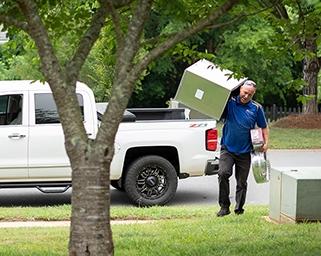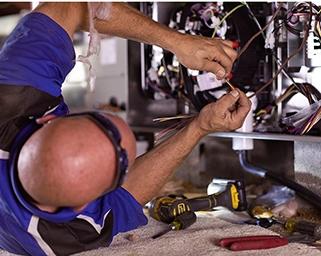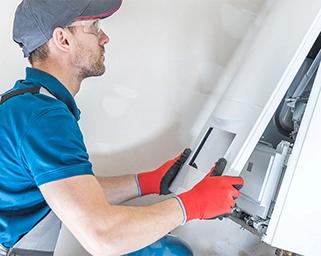8 Furnace Installation FAQs
Learn the key factors that go into furnace installation, from cost and timing to lifespan and efficiency ratings. We’ll also explain when to consider alternatives like heat pumps and how to choose the right installer with confidence.

By Tom Moor
Thinking about replacing your furnace? It’s a significant investment, so it’s natural to have questions about cost, timing, and how to choose the right installer before you dive in. To help, we’ve compiled answers to the most frequently asked furnace installation questions, so you can feel more confident before making your next move.
#1: How long does it take to install a furnace?
Installing a new furnace typically takes about 4-8 hours. Plan to be home in case your installer needs input or something unexpected comes up. Several factors can shorten or extend the installation time, including:
- Type of furnace. Gas, electric, and oil furnaces each have different installation requirements and levels of complexity.
- Existing infrastructure. If you’re simply swapping out an old furnace with a similar type in the same location, the process is more straightforward. If ductwork, wiring, or gas lines need modification or repair, installation will take longer.
- Location. Is the furnace easy to access? Tight or hard-to-reach spaces may add extra time and effort.
#2: How much does furnace replacement cost?
A new furnace is a big investment, and the cost can vary quite a bit. Factors like your home’s square footage, the unit's features, how difficult the installation is, and even your local climate all affect the final price.
On average, homeowners spend between $1,600 and $6,000 on furnace replacement. In some cases, local rebates or federal tax credits can help offset the cost. For the most accurate estimate, a local American Standard® dealer can evaluate your home and provide a personalized quote.
#3: What are some signs your furnace needs to be replaced?
While we all want our furnaces to last as long as possible, there isn’t a set schedule for replacement. Instead, pay attention to how your current system is performing. Signs it may be time to consider a furnace replacement include:
- Old age.
- Frequent repairs.
- Certain rooms never feel comfortable.
- Visible rust or cracks around the system.
- Strange noises.
- Poor air quality.
#4: How long do furnaces last?
A properly installed and regularly maintained furnace can last about last 15-20 years. Higher-quality equipment from top brands such as American Standard may last even longer.
The climate, indoor air quality, and how often the system runs also influence a furnace’s lifespan. Scheduling annual tune-ups and keeping up with air filter changes can potentially add years to your unit.
#5: Should I replace my furnace with a heat pump?
Choosing between a furnace and a heat pump has its pros and cons – and sometimes, the best option is to use both. Ultimately, though, it depends on where you live and what your comfort goals are.
Heat pumps are energy efficient, provide both heating and cooling, and work especially well in moderate climates. In regions with mild winters, such as Florida and Arizona, a heat pump may serve as your only HVAC system.
Furnaces, on the other hand, deliver powerful, reliable heat, which makes them better suited for areas with long, harsh winters.
Some homeowners go with a dual-fuel system (furnace + heat pump) so they get the best of both worlds. If you’re unsure, a local HVAC dealer can walk you through what makes sense for your climate, home, and budget.
#6: What size furnace do I need?
When it comes to furnaces, size does matter. Choosing the right furnace size, measured in British Thermal Units (BTUs) per hour, is key to keeping your home comfortable and energy bills under control.
A furnace that’s too small won’t keep up on the coldest days; if it’s too large, it will short-cycle, wasting energy and wearing out faster. An HVAC professional can calculate the right size based on factors such as your home’s square footage, insulation, and climate.
#7: What is an AFUE rating?
AFUE, or Annual Fuel Utilization Efficiency, tells you how efficient a furnace is. The higher the percentage, the more of your energy dollar goes toward heating your home instead of being wasted. For example, a highly efficient 97 AFUE furnace converts 97% of the fuel into heat, while losing only 3%.
When you’re replacing your furnace, it's important to consider the AFUE rating to balance the upfront cost with long-term savings. Higher-efficiency models might cost more initially, but they can lower your energy bills and may even qualify for rebates. This makes them a smart investment for many homeowners.
The AFUE rating also indicates if a furnace is condensing (above 90% efficiency) or non-condensing. When choosing a furnace, consider venting and drainage needs, as condensing models produce condensation that must be managed to prevent freezing or moisture issues.
#8: How do I find the right HVAC installation company?
Even the best furnace won’t perform properly or efficiently if it isn’t installed correctly. Here’s what to look for when hiring a company to install your heating system:
- Experience and certifications. Licensed, insured, and factory-trained technicians help ensure the job is done right.
- Reputation. Check online reviews, ask for references, and verify their credentials to ensure you're choosing a reliable company.
- Transparency. A trustworthy installer will explain your options clearly, provide a written estimate, and answer all of your questions.
- Support after installation. Warranties, service plans, and ongoing maintenance should all be part of the package.
- Brand loyalty. If you have a preferred furnace brand, look for a company that is authorized to sell and service that type.
Ready to replace your furnace?
Working with a local American Standard dealer gives you peace of mind that your system will be installed correctly and backed by a trusted name. When it’s time for a new system, partner with an American Standard dealer for expert advice, professional installation, and long-term support you can count on.
Author: Tom Moor
Expert review by Amy Gulas, Product Manager, Furnaces
Related articles



